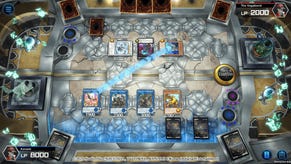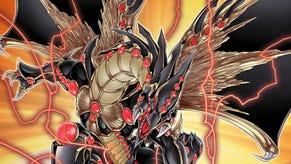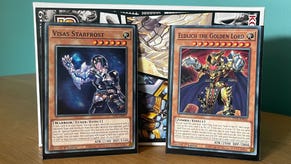Yu-Gi-Oh!’s 25th Anniversary reprints keep its best cards accessible for every player - and should be the norm for every TCG
More cards in more rarities gives players the choice of what they want to buy, without having to cough up ridiculous prices.
The release of the Yu-Gi-Oh! 25th Anniversary Rarity Collection has been received with much praise since its release earlier this month, and it’s easy to understand why. We’ve become accustomed to sets mainly prioritising holographic reprints of in-demand cards over the years (both through the yearly Mega Tins and sets like Hidden Arsenal) but this one was different. Befitting a quarter-century celebration of the beloved card game, Konami truly pulled out all the stops in levelling up the set into a must-have for competitive players.
First, the practical: the reprint selection was exactly what many had been hoping to see. It’s not a new complaint that building the most competitive decks in the game requires a significant investment - to the point it’s no wonder many players choose to vie for off-meta, cheaper picks in order to play (something we’ve advocated for in the past). Still, this set brought most of those highly-sought-after expensive cards needed to elevate these decks to more people via reprints, with critical staples such as various Pot cards, Ghost Belle and Haunted Mansion, Evenly Matched and others. Even many expensive and in-demand archetype-specific cards from the likes of Kashtira and Labrynth got reprints in this release.
No longer was there a need to shell out on expensive singles or buy booster packs in the hope of finding that one sought-after card to complete your deck. Even if you’d long-since built your top-tier meta deck, there was something here for anyone who wanted to bling out their deck with higher-rarity copies of key cards, with every five-card pack featuring an all-holographic array of reprints. This included all-new rarities brought from the Japanese OCG to the West for the first time, like the textured Japanese Ultimate Rares (known here as Prismatic Ultimate Rares), Prismatic Collectors Rare and more on top of the popular limited Quarter Century Secret Rare that debuted with the 25th Anniversary Legendary Collection.
One group wants to own these cards in the most accessible form, while another wants rarer holographic cards that are naturally harder-to-find. The solution? Do both!
Beyond just holographic rarities, there was one more thing borrowed from the Japanese OCG that should certainly be brought forward into future sets. One difficulty in balancing these reprint sets is the conflicting desires of their respective audiences; one group wants to own these cards in the most accessible form, while another wants rarer holographic cards that are naturally harder-to-find to bling out their decks and justify picking up new copies of cards they already own. The solution? Do both!
One natural knock-on effect of placing high-demand cards at high rarities is a scarcity that drives up speculation in the secondhand market. It drives some players away from the game and makes it difficult for new players to invest, leaving the upper echelons of competition not just a question of skill, but of the haves and have-nots. It’s an issue that doesn’t exist to the same extent in the Japanese market. While there are certainly high-value, high-demand cards commanding eye-watering prices as you wander through card shops, more times than not sat right next to them is another copy cheap enough for anyone to buy.
How come? Most Japanese sets employ the same techniques used by Konami to decide rarities in the latest 25th Anniversary Rarity Collection. To satiate the demands of players seeking high-rarity cards in Japan, the best cards of every set will be available in those highly-sought rarities and, lately, also in the blindingly-shiny Quarter Century Secret Rare. These cards will also be available in lower rarities simultaneously, whether that be as a Super Rare, Ultra Rare or sometimes even something as low as a simple Rare or Common.
Take Arias the Labrynth Butler from Age of Overlord. For those after this all-new support introduced to the archetype in the set with the ability to Special Summon other cards for increased consistency, you could acquire this in Super Rare or Secret Rare. Internationally, the card is only available in Secret Rare. (In both regions a Quarter Century Secret Rare variant is also available that’s even more difficult to obtain.) Making the card available at lower rarities has made it much easier to find in Japanese markets without preventing those who enjoy a harder catch being rewarded with extra glitz and glamour. Sometimes a card is available in as many as five different rarities in Japan!
It’s an environment that can only improve the overall health of the game, improving the competitive scene and fostering a more welcoming environment for new players.
With the 25th Anniversary Rarity Collection, Konami adopted a similar multiple-rarity solution for the various cards reprinted in this set, and the results showcase the benefits of this change. In my own experience opening a booster box of the set, I acquired a playset of Ghost Belle & Haunted Mansion in Secret, Ultra and Super Rare printings, and there were many other examples of acquiring cards in multiple rarities over the course of a single box - or even a single pack!
It’s a solution pleasing all, making high rarities for collectors and low rarities for those simply wanting to hop into playing the best decks without being priced out of competition. It’s an environment that can only improve the overall health of the game, improving the competitive scene and fostering a more welcoming environment for new players wanting to learn the ropes without being scared off by the investment needed to avoid being obliterated by experienced players.
One area Yu-Gi-Oh! should be applauded is in improving accessibility on a global scale in recent years. The Rush Duel playstyle now available worldwide via Duel Links was specifically designed to entice younger audiences by simplifying an increasingly-complex game. Games like Duel Links and Master Duel digitise the game and allow new ways for players to engage, while Remote Duels introduced by necessity through the pandemic are another way for players to play competitively without the need to travel large distances.
Even the improved balance of the game to encourage a broader range of playstyles through different archetypes and engines has done away with prior issues where entire formats were defined by a single deck.
Indeed, the issue of the increasing cost of playing Yu-Gi-Oh!, especially in a world where card games are increasingly the target of collectors driving up value during a cost-of-living crisis, is one of the few things yet to be addressed in improving the accessibility of Yu-Gi-Oh! for a broader audience. Or a world where card games like Disney Lorcana have been impossible to acquire and Magic: The Gathering and Pokémon are having their own issues at pricing out new players from investing in their own TCGs.
Does this mean such a policy will become commonplace in future? It’s hard to say. But the success of the testing ground of this policy speaks for itself. The Japanese market showcases a future for how this could be introduced beyond one-off collector sets. It would certainly be a good thing for the health of the game, and surely that would be a good thing.








